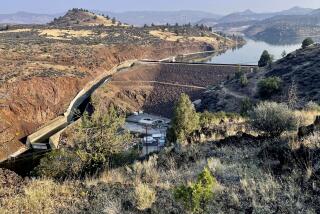The Hearst Deal Works
- Share via
The deal to trade $95 million in public money for the Hearst Land Corp.’s promise to protect nearly 80,000 glorious, rolling acres it owns near San Simeon is a boon for the corporation. But the hard-won agreement, which also gives the public title to 13 of Hearst’s 18 miles along the shore, is a good one for Californians too. The state Wildlife Conservation Board, meeting today in Sacramento, should approve it.
For years, Hearst lawyers battled local and state officials and residents over the corporation’s grandiose plans to chop up this last scenic stretch of the Central Coast into a luxury hotel, a private golf course and a town’s worth of oceanfront palazzos. It is no surprise that when Hearst stopped litigating and began to negotiate, its newfound interest in open-space preservation met with suspicion and lingering bitterness.
Many people fear that company lawyers will drive a bulldozer over broad provisions in the pact, which requires Hearst to inventory and protect the elk, mountain lions, rare frogs and hundreds of other species on its acreage. There are doubts that Hearst will, as promised, let hikers cross beachfront parcels it will keep. Such is the legacy of distrust Hearst has built. For its part, the corporation regards those pressing the state to demand more as pie-in-the-sky activists who won’t rest until the entire ranch is in public hands. That option was never on the table, and taxpayers couldn’t afford it if it was.
No deal works unless both sides get more than they lose. That’s certainly the case here. Californians would buy a guarantee that Hearst’s sweeping tract east of Highway 1 -- the last of its size -- would remain spectacular and all but undeveloped in perpetuity, no small matter considering Hearst’s outsized building appetite. On the highway’s west side, once state parks officials cut down the barbed wire Hearst has strung, anyone will be able to feel the ocean spray and watch diving pelicans and sunbathing seals.
The agreement would give Hearst $80 million, mostly from state conservation bonds, and a $15-million state tax credit, and would allow it to seek a federal charitable deduction of perhaps $135 million. The corporation also gets the right to plant some vineyards and orchards, build 27 homes tucked into the hills and construct a 100-room inn at Old San Simeon Village. Like any proposed development, these projects must pass normal state and local building reviews, including by the Coastal Commission.
The deal is a reasonable trade-off between public and private rights and should encourage other large landowners to follow suit. The wildlife board is the first of three state agencies that must sign off on this pact. Once that happens, Hearst must prove itself worthy of the public’s money and trust.
More to Read
Inside the business of entertainment
The Wide Shot brings you news, analysis and insights on everything from streaming wars to production — and what it all means for the future.
You may occasionally receive promotional content from the Los Angeles Times.










